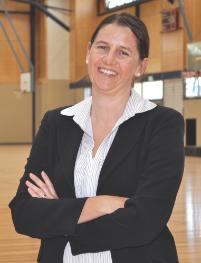Give try-hards a sporting chance, says Uni researcher
Published on 19 November, 2009
CQUniversity researcher Danya Hodgetts* says this week's national Crawford Report on sports funding options has got it right ... it's time the pyramid was turned upside down, in favour of the 'try-hards'.
"If you think of sport as a pyramid, there are us sporting try-hards at the bottom; those that do it for fun, fitness and friendship," she says.
LINK HERE to the Independent Sport Panel Report (Crawford Report)
----------------------------------------------------------------------------
"As a result of the Crawford Report we may not be in the top 5 at the Olympics,
but we may be on our way to a healthier nation.
And who knows what might trickle up?"
----------------------------------------------------------------------------
"The base of the pyramid is wide, representing the large numbers playing sport (and let's not forget the coaches and officials and administrators) at this level.
"As you move up the pyramid, the level of performance gets higher and the number of people decreases. This is quite similar to organisational structures that show a CEO and executive at the top of the pyramid, middle management in the middle, then frontline staff and finally clients at the base.
"Contemporary management speak recommends that the pyramid be turned upside down so that the most important people are at the top. I think this applies to sport, and the Crawford Report seems to support this notion.
"Last week it was all about Tiger. Yes, apparently Tiger Woods was in town. This week, there are reports of children filling golf lessons and driving ranges around Australia. But will the 'Tiger effect' bring about a long-term benefit for golf? Or a long-term benefit for those children who might otherwise be playing golf on a computer at home? This phenomenon is referred to as the trickle-down or demonstration effect. It asserts that good performance at the top (assuming the pointy bit is at the top) encourages more people to take up sport at lower levels.
"There is a demonstrated link between funding levels and success at the elite level, but there is no empirical evidence to support that this success 'trickles down'.
"The trickle-down effect has been used to justify a greater proportion of funding going to elite rather than community sport ... This concept is overly simplistic and too generalised to be universally successful. It appears that sport recognises (albeit without acknowledging) this, with elite sports now recognising that owning their grassroots participation structures will contribute to their elite success.
"Yes, elite athletes inspire and motivate us. Yes, there are more children playing tennis in February after the Australian Open each year. Yes, it's great that Australia performs well on the international sports arena. But there is no evidence to support that this translates into a more active and healthier Australia; the current obesity figures suggest not.
"Remember the Sydney Olympics? Sydney's successful bid for the 2000 Olympic Games included a claim that, among other benefits, the event would create increased participation in sport. Indeed, the Australian Sports Commission viewed the Games as an opportunity to harness motivation and to promote grassroots sport.
"Despite these good intentions and some AUD$2.3 billion spent on the conduct of the event, there were no programs specifically conducted for the enduring benefit of sport organisations.
"There were some anecdotal findings that the event created a greater interest in sport ... However, there was no evidence that the event had any impact on sport participation or sport clubs in Australia.
"As a result of the Crawford Report we may not be in the top 5 at the Olympics, but we may be on our way to a healthier nation. And who knows what might trickle up?
* Danya Hodgetts is completing her PhD examining how major events can be leveraged to create legacies for community sport. She is not an elite athlete.


